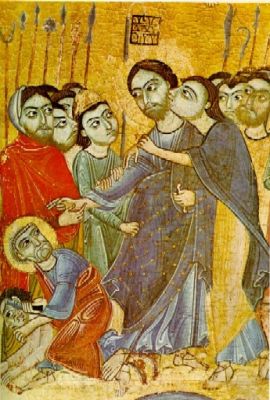 Readers of GetReligion are familiar with that mainstream media holiday tradition of releasing news stories that are supposed to shake the foundations of Christianity. Easters over the last few years have featured stories that Jesus walked on an ice floe (not water), that he wasn't crucified in the manner in which people think, that Jesus' father was a Roman soldier named Pantera, not Joseph, and that Jesus didn't die on the cross so much as pass out after being doped up.
Easter 2006 featured an unrelenting public relations offensive (emphasis on offensive) by the National Geographic Society and its National Geographic magazine that argued that Judas was unfairly maligned by Christians. The story was covered far and wide by all the major media outlets.
Readers of GetReligion are familiar with that mainstream media holiday tradition of releasing news stories that are supposed to shake the foundations of Christianity. Easters over the last few years have featured stories that Jesus walked on an ice floe (not water), that he wasn't crucified in the manner in which people think, that Jesus' father was a Roman soldier named Pantera, not Joseph, and that Jesus didn't die on the cross so much as pass out after being doped up.
Easter 2006 featured an unrelenting public relations offensive (emphasis on offensive) by the National Geographic Society and its National Geographic magazine that argued that Judas was unfairly maligned by Christians. The story was covered far and wide by all the major media outlets.
In December of last year, I noted April DeConick's op-ed in the New York Times arguing that the National Geographic version was completely wrong about Judas as hero.
The latest Chronicle of Higher Education, which I found via Peter Smith, the religion reporter of the Louisville Courier-Journal, analyzes what went wrong. As the name of the publication indicates, the story deals mostly with the politics and personalities of higher education. But it's also an indictment of the media:
[S]ome members of the team were sent to a one-day media-training seminar in Manhattan to prepare them for the coming onslaught of attention. They would have to explain to reporters, repeatedly, that the Gospel of Judas was probably written in the second century, long after the actual Judas was dead. There is no scholarly debate over whether the conversations in the gospel actually took place. Everyone agrees that it's fiction, but it's fiction that reveals how a certain sect of Christians viewed the meaning of the crucifixion and the role of Jesus' disciples. . . .
One of the questions the National Geographic team was asked most frequently was "Is it the real thing?" -- which, of course, depends on what you mean by "real" and "thing." The manuscript is real in the sense that it's not a fake. And it does appear to be the Gospel of Judas referred to in the writings of one early church father. But it is not a journalistic account of conversations between Jesus and his disciples, nor could it have been written by the historical Judas. That message didn't always come through: Some of the news reports read as if the gospel came straight from Judas' pen. . . .
Reporters ate it up. Word of the discovery made the front pages of newspapers around the world. "Ancient Text Says Jesus Asked Judas to Hand Him to the Romans" was The Arizona Republic's headline. USA Today said the gospel "recasts" Judas. The Austin American-Statesman put it this way: "Ancient Judas as 'good guy,' not Jesus' betrayer."
The Chronicle article explains in detail the myriad ways in which the team of bible scholars hired by National Geographic messed up. They translated the word diamon as "spirit" instead of "demon." There were other problems:
Then there's the number 13. The Gospel of Judas is thought to have been written by a sect of Gnostics known as Sethians, for whom the number 13 would indicate a realm ruled by the demon Ialdabaoth. Calling someone a demon from the 13th realm would not be a compliment. In another passage, the National Geographic translation says that Judas "would ascend to the holy generation." But DeConick says it's clear from the transcription that a negative has been left out and that Judas will not ascend to the holy generation (this error has been corrected in the second edition). DeConick also objected to a phrase that says Judas has been "set apart for the holy generation." She argues it should be translated "set apart from the holy generation" -- again, the opposite meaning.
DeConick's problems with the translation are now shared by a growing chorus of scholars. The scholars who mistranslated the work, who largely agree that they messed up, feel that she should have handled her concerns privately rather than outing them in the New York Times. DeConick disagrees, saying that all most people will remember is the Judas as good guy impression created by the media.
She is, of course, correct. The media offensive during Holy Week two years ago cast major doubt on the historic teaching of the Christian faith. The revelation that there were major, major problems with that story? Well, unless you happened to read a December New York Times op-ed or subscribe to the Chronicle of Higher Education, you won't hear a word.
